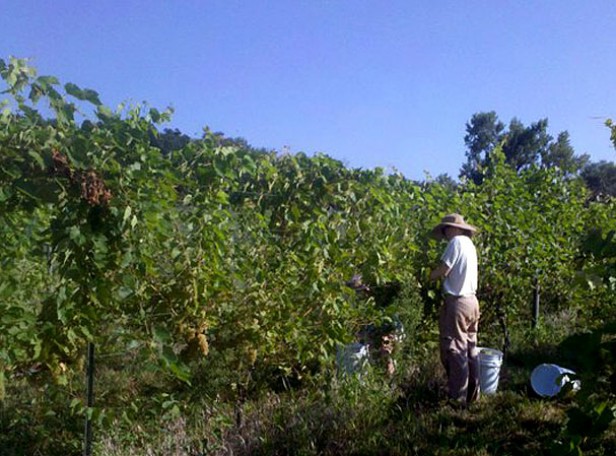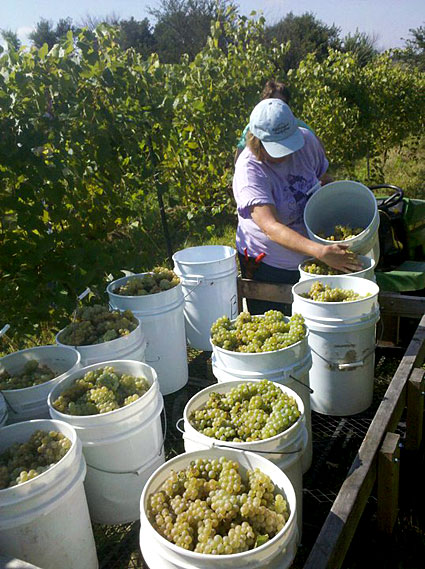 Harvesting grapes at Big Cottonwood winery in Nebraska. (Steph Larsen photos)
Harvesting grapes at Big Cottonwood winery in Nebraska. (Steph Larsen photos)
When you think of wine, you probably picture French or Italian bottles, or perhaps rolling California hills covered with Pinot Noir grapes.
I think of Iowa.
Believe it or not, Iowa and eastern Nebraska have a long tradition of growing grapes and making wine. Iowa’s wine-making history dates back to the late 19th century. In 1900, the state produced over 3,500 tons of grapes, some of which went into making 76,000 gallons of wine. At its peak in 1929, Iowa produced 7,500 tons of grapes. Three events in rapid succession led to the demise of Iowa’s grape production: Prohibition, from 1919-1933, caused most vineyards to pull up their vines, thinking the market had disappeared for good; the Armistice Day blizzard of 1940, whose 80 mph winds and snowfall of up to two and a half feet devastated newly replanted grape vines; and starting in 1946, the rise of a pesticide called (awkwardly) 2, 4-D. Grapes are particularly sensitive to 2, 4-D, and under the wrong conditions will wilt from herbicide that was sprayed miles away.
The last decade, however, has seen a remarkable resurrection of grape growing in Iowa and eastern Nebraska. The trend toward having a relationship with the producers of your food has probably helped, and more growers are adding value to their products by processing them. In 1999, there were two licensed wineries and three grape vineyards in Iowa. Now there are 32 and 230, respectively.
 Big Cottonwood winery(Steph Larsen)I spent a recent morning harvesting grapes at a nearby winery in northeastern Nebraska, aptly named Big Cottonwood. I learned that a grape fork is not a utensil for overly polite fruit eaters, but rather a very handy harvesting tool that insures this clumsy woman’s fingers stay intact.
Big Cottonwood winery(Steph Larsen)I spent a recent morning harvesting grapes at a nearby winery in northeastern Nebraska, aptly named Big Cottonwood. I learned that a grape fork is not a utensil for overly polite fruit eaters, but rather a very handy harvesting tool that insures this clumsy woman’s fingers stay intact.
Big Cottonwood grows six varietals with names like Prairie Star and Seyval on 40 acres. It’s operated by a lovely couple who both work full-time off the farm. Luckily, they have friends and wine enthusiasts willing to volunteer a morning in the sun in exchange for a nice brunch and an excuse to drink wine at 11 a.m. on a Saturday. After we finished harvesting in the field, we watched various machines de-stem the grapes and pump them into a barrel-shaped hydraulic press that slowly and gently squeezed out the cloudy green juice.
Big Cottonwood is quite the value-added enterprise, and a steady number of customers visit their off-the-beaten-track location for a chance to sample their sweet whites and semi-dry reds. At their tasting room, you can buy their wine as well as wine-themed crafts from area artists. While chatting with the other grape harvesters, I may even have found another potential customer for one of our lambs.
On the car ride home, my partner and I started considering how many small agricultural enterprises there are in our area: Two wineries, a greenhouse, several small CSAs, and several more producers for the Nebraska Food Co-op.
We started thinking how these entrepreneurs could work together to sell and/or advertise each others’ products, reaching customers they wouldn’t otherwise reach while not competing with their neighbors. There seems to be more than enough demand to go around for locally grown or made products, and I’m sure each of these enterprises appeals to a distinctly different niche.
By working together, we might even turn Burt County into a food destination, where people in search of delicious local treats would tour the countryside, sampling what we have to offer.
But the existence of Big Cottonwood and the nearby Silver Hills Winery is somewhat precarious thanks to 2, 4-D, or rather, the next big thing in biotechnology: crops like corn and soybeans that have been engineered to be resistant to it. I’d never heard of 2, 4-D until I moved to Nebraska, and I was confused as to why people kept referring to something happening at 2:40. I quickly learned that it is one of the most commonly used broadleaf pesticides in the world.
Though early propaganda by chemical companies promised that planting crops resistant to glyphosate (aka Roundup, manufactured by Monsanto) would decrease herbicide use, we’ve seen exactly the opposite happen [PDF]. As overuse makes one herbicide less effective, chemical companies quickly develop new genetically modified plants that can survive applications of different and stronger weed-killing chemicals.
Grapes are particularly sensitive to herbicides in general, and it’s reasonable to fear that these budding wineries could once again see their hard work fall victim to the likes of 2, 4-D. The chemical comes in two forms: a salt and a more potent form called an ester (basically the combination of an alcohol and the acid). The ester formulation easily volatilizes into a vapor, and any plant that the vapor cloud touches will show signs of damage.
It’s hard to tell your country neighbors — nice folks who plow you out when it snows, or watch your animals for you when you’re gone — that if their herbicide drifts onto your pasture or market garden, you’d have to ask them to pay for damages. In such situations, ill feelings are easy to create and hard to mend, especially in communities where it’s difficult to make ends meet.
Get off your ass opportunity: So if you’re lucky enough to have a winery nearby — and a surprising number of states do, not just Californians — support their efforts (cheers!), as well as organizations like the Institute for Responsible Technology that are trying to keep more herbicide-resistant crops off the market (and me on good terms with my neighbors).




